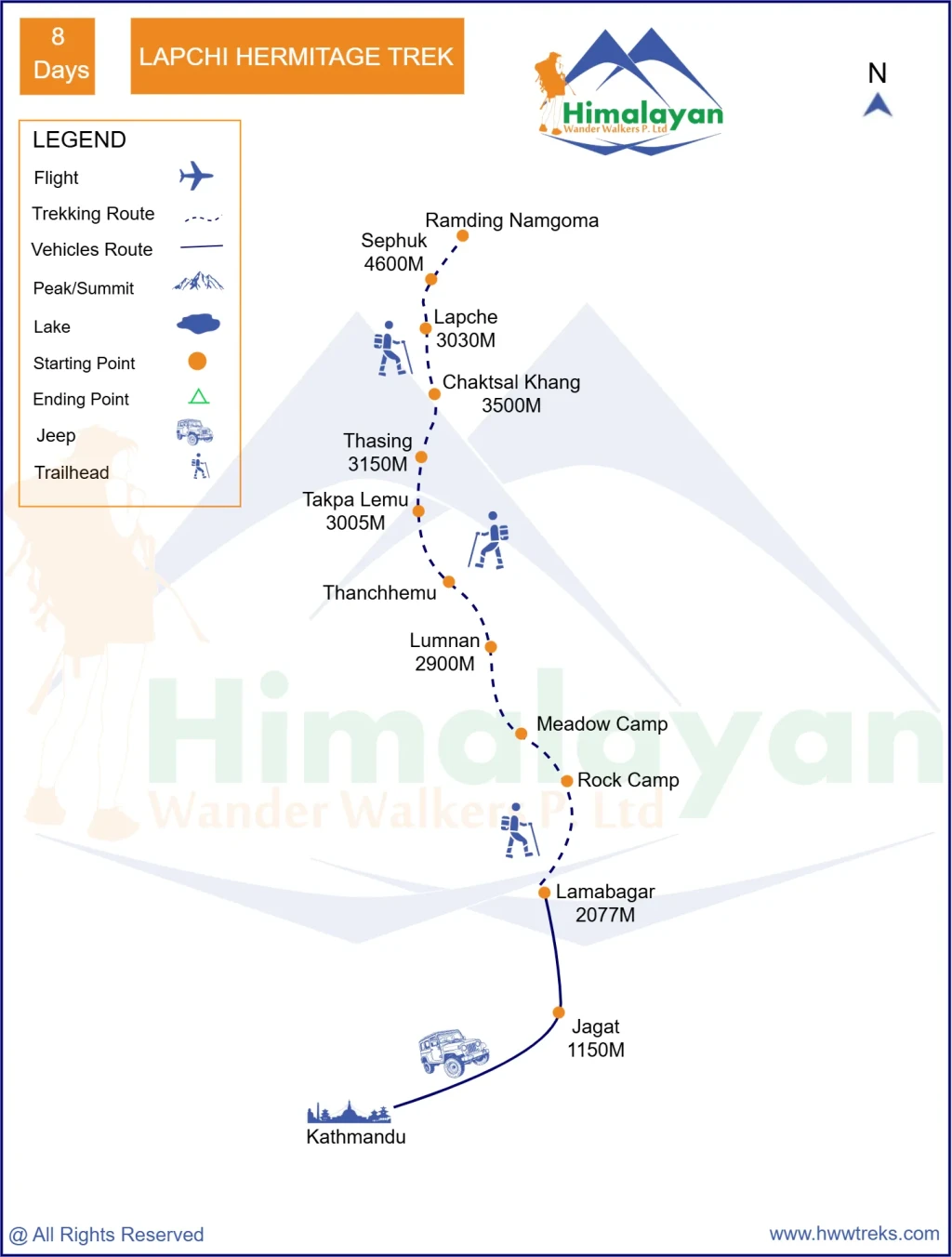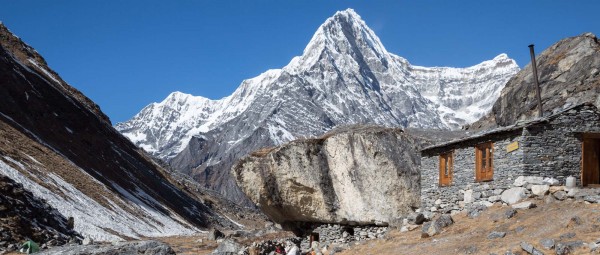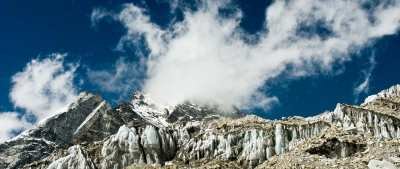Important Information
Region
Rolwaling Region Treks
Duration
8 Days
Max Altitude 4900m
Best Season March - November
Activity Per Day
5-6 hrs
Grade
Level 3
Group Size
2 - 12 people
Transportation Jeep
“Lapche valley Trek is one of the desirable trekking routes in the Himalayas of Nepal which is recommended by all travelers who had visited there.”
Lapchi or Lapche is a paramount spiritual mountain which is known as the Milarepa’s hermitage. It is located in Rolwaling in the eastern part of Nepal at a height of about 4850 meters along the border of Nepal and Tibet. This trek offers an opportunity to discover the least visited remote and exciting secreted corners of Nepal. Lapchi trek and Lapchi area is the scared destination in the Himalayan after Kailash and Tsari.
You can visit the monastery showcases the religious and spiritual heritage of more than 400 years old. This area is related to Milarepa, — a twelfth-century Buddhist sage and poet who served as the spiritual figurehead of the Kagyupa sect of Tibetan Buddhism. Milarepa is not only a Buddhist yogi but also an ancient Tibetan poet and singer.
Besides pilgrimage, this trek offers an outstanding view of the Himalayas that lies along the northeastern side of the finger land and that just form. Some of the highlights of this trek are Rolwaling valley, Tamang village, and wonderful views of an alpine lake, Hanging glaciers, moraines, high pastures, waterfalls, and imminent view of snowy peaks in the backdrop. This is a popular region with isolated villages, biological diversity, glacial lakes, and mountains. Rolwaling trek combines the view of Mt Melungtse, Mt Dorje, and Mt Tashi Lapcha, beautiful waterfalls, and the Tso Rolpa Lake.
Highlights of Lapchi Trek
- Discover the art and architecture of the monasteries and caves,
- Explore the scenes of surrounding mountains and other natural formations of this high alpine region.
- Buddhist pilgrimage as a charming destination of Milarepa.
If you are looking for a different itinerary than the itinerary here, please Customize Your Trip.
Include
Private Jeep to the start and end of the trek
English-speaking government license holder trekking guide
Porter per two-person
Trekking guide’s and porter’s insurance during the trip
TIMS trekking permit
National park permit
Camping equipment and food during the trek
Homestay or local lodges
Three meals plus teas per day during the whole trek
Exclude
Personal trekking equipment
Travel/medical insurance
Emergency rescue evacuation
Phone calls
Internet
International air ticket
Tips for your trekking guide & porters at the end of the trek
If you’re forced to extend your trek due to bad weather or natural disaster circumstances, we are not liable to pay any compensation or otherwise be responsible for any expenses you may incur
Anything not mentioned in the ‘includes section’
Route Map

Important Information
* The Price given here is per person based on a minimum of 2 pax. The price will be cheaper with an increase in the number of people.
* Single Supplement is applied (in case you are single)
CHECKLISTS FOR LAPCHI HERMITAGE TREK
- Valid passport (valid for six months from the date of your trip)
- MasterCard, Visa Credit, and Debit Cards are accepted in Nepal. However, some cash is highly recommended.
- Mobile (if your cell phone is from CINGULAR USA or ATNT (USA) operators, then your cell phone will work in Nepal.)
- Clothing (Layered clothes, windproof and waterproof jackets, fleece pullovers, thermal base layers, hiking pants, shorts, headwear, footwear, and other items according to your needs)
- Personal Items and Toiletries (First-Aid Kit, Iodine tablets or a UV purifier to treat water, Sun Protection)
- Travel and Health Insurance
- Trekking gear and equipment(if you have your own trekking gear and equipment, such as trekking poles, sleeping bag, and shoes, then you can bring them; else you can rent them in Thamel, Kathmandu). Read more for trekking gears and peak climbing gears.
Guiding, Food, and Camping
In Nepal, all trekking supplies - camping equipment, kitchen implements, food - are all carried by pack animals like mules, Yaks, and horses. Even Porters are common in Nepal. All trekkers are accompanied by a guide, a cook, and usually at least one horseman or yak herder. With the surest footing; they lead trekking groups across the passes. The horseman and cook will usually run ahead during a trekking day. They will have prepared a packed lunch for hikers and will go on to the night’s resting place to set up camp. They set up tents, cook dinner, and ready the area for arriving trekkers. When trekkers reach the campsite they are greeted with a hot cup of tea and biscuits in the dining tent. After six hours in the mountains, no drink will ever taste sweeter. For dinner, the cook will usually prepare a buffet of dishes that are as welcome as they are delicious.
DRESS CODE FOR VISITING MONASTERIES, AND TEMPLES
- Shirt (either half or full sleeve)
- Full pants/long skirts
- Any type of shoes with socks
- No Hats, No Umbrella, No Slippers, No t-shirts, No short skirt, and No half-pants
- Photographs allowed in the courtyard only.
Note regarding itineraries
Although we generally adhere to the schedule, the itinerary is subject to change for numerous reasons beyond our control, including weather and terrain conditions, suitable campsite availability, and the group's general fitness level. It is important to understand that our trek is logistically complex and it is not unusual that adjustments be made. Our guide will orient you each evening to the following day's plan; their good judgment is the key to the long history of successful treks that Himalayan Wander Walkers has led till now. Please remember that our ability to make adjustments as needed helps to ensure that your trek is successful.
Frequently Asked Question
Yes, you can customize the Lapchi hermitage Trek according to your preferences. Whether you want to stop and spend a day or night in a specific location or tea house, or you want to add a side trek, just let us know what you're looking for, and we’ll be happy to accommodate your wishes: “Customize Your Trip.”
The Lapchi hermitage trek is a spiritual trek toward a mystical mountain known as Milarepa Hermitage. This trek includes a walk through the least visited and remote villages of Nepal, uncovering the arts and architecture of Buddhist monasteries, the sacred Milarepa caves, numerous waterfalls, and so on.
Yes, a guide is highly recommended, especially when trekking to remote areas of Nepal, including the Lapchi Valley, where there are rugged terrains and no proper trekking routes. Guides also provide valuable insights into the local culture, history, and landscapes, and they can assist with any issues, such as altitude sickness or changing plans due to weather-related issues.
For the Lapchi hermitage trek, one needs to have the Lapche Restricted Permit and Gaurishankar Conservation Permit, which can be obtained from the Nepal Immigration Department through registered and authorized trekking agencies. Read more about trekking permits for the Lapchi Valley.
Yes, you might get altitude sickness during the Lapchi Hermitage trek as altitude sickness can occur in regions above 2,500 meters and Lapchi lies at the elevation of 4900meters. Staying hydrated, eating well, and ascending gradually are the best ways to prevent altitude sickness. If you experience symptoms like dizziness or headaches, inform your guide immediately so they can follow the necessary protocols.
For the Lapchi Hermitage trek, Spring and autumn is the best season, avoiding the monsoon. There will be plenty of greenery along with stable weather and clear sky during these seasons and one will have less risk of altitude sickness and with a chance to see the Rhododendrons along the routes. Read more about the best season for trekking in the Lapchi Valley.
The cost of the Lapchi Hermitage trek starts from USD 1040(all-inclusive price) per person and depends on many factors, including the season or time one chooses to trek, the mode of transportation, accommodations, and lodging, and many more. Read more about trekking costs in the Lapchi Valley.
While packing for the Lapchi Hermitage trek, you'll need sturdy trekking shoes, warm clothing, a sleeping bag, water bottles, sunscreen, a hat, energy snacks, and a small first-aid kit. Make sure to pack light but wisely to stay comfortable during the trek, considering the varying weather conditions. Read more about trekking gear and equipments.
No questions found matching your search. Try different keywords or browse all questions above.
| {{type.min}} - {{type.max}} Pax {{type.name}} - {{type.desc}} | {{type.display_price}} per people |
Extra prices:
Let us help you decide Inquiry
You might also like

- 19 days
- Rolwaling Region Treks
Rolwaling Tashi Lapcha Trek
The Rolwaling valley is tucked between two impressive mountain ranges the Gaurishankar Himal and the Rolwaling Himal. The Rolwaling includes Melungtse (7181m) and Melungts II (2073m) both of which can be seen from Melunga – on the Tibetan side, and the Gaurishankar Himal includes...
